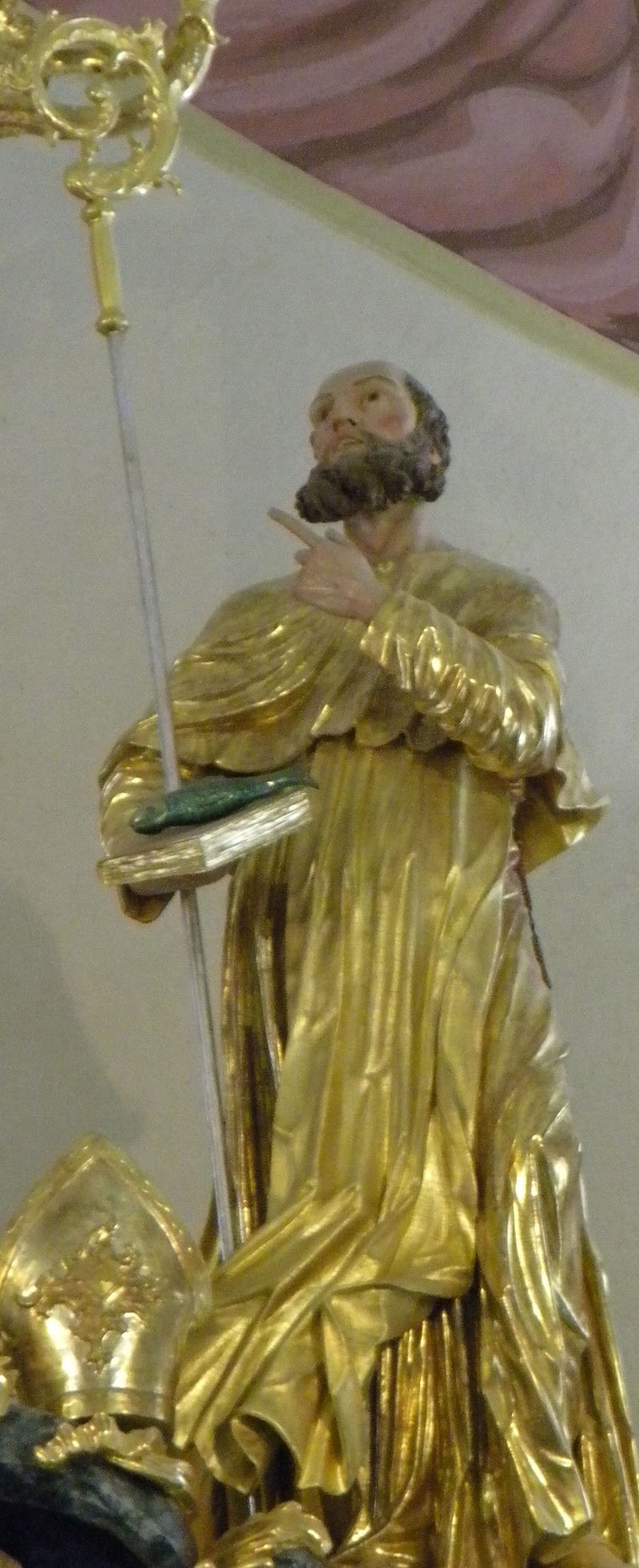In New Testament usage, Saint was a name that was applied to Christians in general, much as the word is used by Protestants today. However, early in the history of the Catholic Church, the word was restricted to men or women who were eminent in their holiness and, in the strictest sense a saint referred to those who distinguished themselves through heroic virtues during their life, and whom the Church honors as saints through a process known as canonization. The Church's official recognition of a person's sainthood implies that the person is now in heavenly glory, that their virtues during their life, or through a martyr's death, are a witness and example to all Christians, and that they may be invoked through prayer. In the Catholic Church, a person can be elevated to sainthood only after their death, and then only after a thorough investigation of the person's life indicates that they lived a saintly life while alive, and that some undisputed miracle took place through their intercession. Catholic devotion to the saints indicates respect and admiration for a deceased hero or heroine of the Church. There is a type of saint, within the Catholic Church, who is known as a Patron Saint. A patron saint is one who is regarded as a heavenly advocate or intercessor for a nation, place, craft, activity, clan, family, person, or specific illness or injury. Catholic believe that patron saints are able to intercede for the needs of their charges. For example, Augustine of Hippo is regarded as the patron saint of sore eyes, while Bernardine of Feltre is the patron saint of pawnbrokers, and Saints Anne, Jean de Brébeuf, and Joseph are the patron saints of Canada. Saint Patrick, of course, is the patron saint of the Irish, and Saint Ignatius of Loyola is the patron saint of the Basques.
Categories
CeciliaJoan of Arc | JudePadre Pio |
Feature Article
The Process of Becoming a Catholic Saint

Although there is no official count, there are more than ten thousand Roman
Catholic saints, the first being Saint Ulrich of Augsburg in AD
993. Before that time, Christians
were recognized as saints by popular opinion, generally because they had
been martyred. In time, the Catholic
Church codified the process for attaining sainthood, the most recent
changes coming about with the Vatican II Council.
Vatican II and subsequent directives from Pope John Paul II have simplified
the process for canonization as a saint. The most significant change deals
with the Cause of Beatification. According to current rules, it is the
diocese that gathers the information arguing for or against the canonization
of a candidate for sainthood, and inquiries are also now conducted during
the diocesan phase. It is the diocese that gathers evidence of heroic
virtues, martyrdom, sanctity, and miracles that may be attributed to the
candidate. Prior to Vatican II, the process of beatification went back and
forth between the Vatican
and the diocese, complicating the process and lengthening the time involved.
For one thing, prior to Vatican II, there were two distinct steps involved:
Beatification and Canonization. Now, beatification is considered to be the
first stage toward canonization, and not a wholly separate process.
Prior to Vatican II, a Cause for Canonization had to be introduced by the
Pope himself, leaving those who had an interest in the matter to lobby the
Vatican before the process could even begin. Today, the bishop of the
diocese in which the candidate died is given the sole authority to introduce
a Cause of Canonization, although the authority to beatify or canonize a
candidate remains in the hands of the Pope. Vatican II and papal directives
are intended to simplify the process, as well as encouraging communication
and cooperation between diocesan bishops and the Pope.
Before, the Cause for Canonization was known as the Process of Beatification
and Canonization. Now, the process consists of the gathering of information
by the diocesan bishop or whoever he might appoint.
While the 1917 Code of Canon Law had dozens of canons pertaining to a Cause,
the revised code has only one canon that specifically relates to all Causes:
canon 1403. The most obvious change has to do with the introduction of a
Cause. As noted earlier, the Pope was the only one who could introduce a
Cause previously. In 1969, Pope Paul VI issued an apostolic letter dictating
that the local bishop could formally introduce a Cause for sainthood, but
only after he had received permission from the Holy See to do so. This was
intended to involve the diocese in the early stages of a Cause, and to
encourage communication between the diocese and the Holy See.
This was still a lengthy process, requiring a lot of back and forth between
the diocese and Rome. This proved to be only a first step, however. Under
current rules the bishop of the diocese in which the candidate died can
introduce a Cause on his own authority, and without the permission of the
Pope. The local bishop is required to notify the Holy See that he has
introduced a Cause, but this is now consultive.
The preliminary and immediate phases of the beatification process are
currently handled by the diocese, who makes inquiry of the Holy See,
regional bishops, the petitioners, and any experts or witnesses who may be
called to testify. During the initial phase, the petitioner takes the first
steps to advance a Cause in the form of a letter to the bishop. Then, the
petitioner selects a postulator, who must be approved by the bishop, and the
postulator may select a number of aides. The postulator investigates the
life of the candidate with an eye toward finding proof of a life of heroic
virtue or martyrdom. The postulator will also determine whether the
candidate has a reputation for sanctity, and to find evidence that there is
a system of religious veneration or adoration directed toward the candidate.
Upon conclusion of this investigation, this evidence along with a biography
of the candidate is presented to the bishop for review.
At this point, the bishop determines whether he will accept the letter of
petition. If so, he may decide to handle the Cause himself or assign a
delegate to do so. If the letter of petition is accepted, the postulator
will present a list of witnesses for and against the candidate who will be
questioned by the bishop or his representative. The bishop will also appoint
someone to oversee the inquiry, ensuring that the proceedings are carried
out appropriately. That concludes the preliminary phase.
During the immediate phase of a Cause, the bishop publishes the petition,
making the introduction of the Cause public, so that anyone with additional
evidence for or against the Cause may have an opportunity to come forward.
The bishop will also appoint two theological consultors who will study the
writings of the candidate, ensuring that he or she has not written anything
contrary to the teachings or ethics of the Catholic Church. The bishop then
consults with regional bishops as to the appropriateness of the Cause. If
this evaluation is positive, the bishop notifies the Holy See.
The Holy See then seeks to determine whether there is anything that might
obstruct the advancement of the Cause. If nothing negative is determined,
then the Holy See will instruct the bishop to continue with the immediate
phase of the Cause.
The bishop will then set into motion a diocesan inquiry with the witnesses,
appointing a notary to witness the proceedings and to sign and seal each
piece of documentation. Once the inquiry is completed, a transcript, known
as the Acts of the Cause, is sent to the Congregation for the Causes of the
Saints in Rome, while the original copy remains with the diocese. This
concludes the the diocesan inquiry phase.
Next, the Congregation for the Causes of the Saints studies the Acts of the
Cause and prepares a comprehensive Position on the Life and Virtues or
Martyrdom of the candidate, then a Position on the Miracle, which is a
detailed report of the Acts of the Cause. The bishops and cardinals will
also study and discuss the Position on the Miracle, offering their opinions.
The final step of beatification is in the hands of the Pope, who reviews the
evaluations of the bishops and cardinals, and makes the final determination.
The Pope has the authority to intervene at any step of the process, and may
stop or advance the process at any point.
Recommended Resources
This independent work features profiles of several of the canonized saints of the Roman Catholic Church, including a story of the life and death of the saint, an overview of their lives and deaths, and why those named a patron saint has come to be associated as a special patron of a cause, country, profession, illness, or activity. Other resources and information related to the saints is also presented.
http://www.catholic-saints.info/
The site offers thousands of articles and topics related to the saints, including those saints who were part of the Church hierarchy as abbesses, abbots, bishops, canons, cardinals, deacons, missionaries, monks, nuns, priest, or popes. Also featured are those who were converts to Catholicism, fathers or mothers, lay brothers, life-long lay people, married, martyrs, or slaves. The various occupations and other characteristics of individual saints are also highlighted.
http://catholicsaints.info/
The site features cartoon artworks of several patron saints and other biblical figures, which are made available for purchase online in book form, as well as posters in various sizes, calendars, and other items, such as caps, tee-shirts, cups, keychains, coffee mugs, mouse pads, stickers, and magnets. A directory of the saints who are available here is included, along with reviews.
http://www.happysaints.com/
Available in several languages, the site offers general information about saints in Catholic scripture, tradition and dogma, as well as the writings of several of the saints, a discussion of the changes brought about in the process of sainthood by the Vatican II Council, and specific information about individual saints, including biographies, information about the factors that led to canonization, and other details.
http://www.catholic-saints.net/
The definition of a Roman Catholic saint is given, including some of qualities that might make someone a candidate for sainthood, in the eyes of the Church. The Incorruptible Saints are highlighted, as are those who were martyrs. An alphabetical list of saints is provided, with biographies of each. Other resources include the Marian and Franciscan calendars, Saints calendars, and the titles of Mary.
http://www.roman-catholic-saints.com/
Saint Andrew the Apostle was the first disciple of Jesus, and the younger brother of Saint Peter, and is the Patron Saint of Scotland. A biography of the saint is presented here, along with the ways in which he is remembered within the Christian church. A list of cathedrals named for the saint is included, with photos of several. Other resources include Saint Andrew medals, the Saint Andrew’s Cross, the Feast Day of Saint Andrew, and prayers to Saint Andrew.
http://www.saintandrew.us/
Saint Nicholas Center provides information on this Christian saint, who is popularly identified with Santa Claus, offering the true biography of the man, who was born during the 3rd century in the village of Patara, then part of Greece, but now on the southern coast of Turkey. The origins of the Santa Claus mythology is included, along with comparisons between Saint Nicholas and Santa Claus
http://www.stnicholascenter.org/


